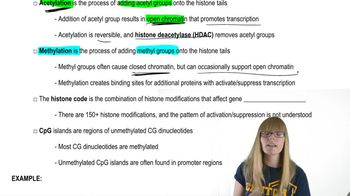What parts of the genome are reversibly methylated? How does this affect gene expression?
Table of contents
- 1. Introduction to Genetics51m
- 2. Mendel's Laws of Inheritance3h 37m
- 3. Extensions to Mendelian Inheritance2h 41m
- 4. Genetic Mapping and Linkage2h 28m
- 5. Genetics of Bacteria and Viruses1h 21m
- 6. Chromosomal Variation1h 48m
- 7. DNA and Chromosome Structure56m
- 8. DNA Replication1h 10m
- 9. Mitosis and Meiosis1h 34m
- 10. Transcription1h 0m
- 11. Translation58m
- 12. Gene Regulation in Prokaryotes1h 19m
- 13. Gene Regulation in Eukaryotes44m
- 14. Genetic Control of Development44m
- 15. Genomes and Genomics1h 50m
- 16. Transposable Elements47m
- 17. Mutation, Repair, and Recombination1h 6m
- 18. Molecular Genetic Tools19m
- 19. Cancer Genetics29m
- 20. Quantitative Genetics1h 26m
- 21. Population Genetics50m
- 22. Evolutionary Genetics29m
13. Gene Regulation in Eukaryotes
Epigenetics, Chromatin Modifications, and Regulation
Problem 7
Textbook Question
Provide a brief description of two different types of histone modification and how they impact transcription.
 Verified step by step guidance
Verified step by step guidance1
Step 1: Understand that histone modifications are chemical changes to the histone proteins around which DNA is wrapped, affecting how tightly or loosely DNA is packaged and thus influencing gene expression.
Step 2: Describe acetylation as a type of histone modification where an acetyl group (−COCH₃) is added to lysine residues on histone tails, which neutralizes positive charges and reduces histone-DNA interaction, leading to a more open chromatin structure and increased transcription.
Step 3: Describe methylation as another type of histone modification where one or more methyl groups (−CH₃) are added to lysine or arginine residues on histones; depending on the specific site and degree of methylation, this can either activate or repress transcription.
Step 4: Explain that acetylation generally promotes transcription by loosening chromatin, making DNA more accessible to transcription factors and RNA polymerase, while methylation can have dual roles—either activating or repressing transcription based on the context of the modification.
Step 5: Summarize that these histone modifications are part of the epigenetic regulation mechanisms that dynamically control gene expression without altering the underlying DNA sequence.
 Verified video answer for a similar problem:
Verified video answer for a similar problem:This video solution was recommended by our tutors as helpful for the problem above
Video duration:
28sPlay a video:
Was this helpful?
Key Concepts
Here are the essential concepts you must grasp in order to answer the question correctly.
Histone Modifications
Histone modifications are chemical changes to histone proteins around which DNA is wrapped. These modifications, such as methylation and acetylation, alter chromatin structure and influence gene accessibility, thereby regulating gene expression.
Recommended video:
Guided course

Histone Protein Modifications
Histone Acetylation
Histone acetylation involves adding acetyl groups to lysine residues on histone tails, neutralizing their positive charge. This reduces histone-DNA interaction, leading to a more relaxed chromatin structure that promotes transcription by allowing transcription factors easier access to DNA.
Recommended video:
Guided course

Histone Protein Modifications
Histone Methylation
Histone methylation adds methyl groups to specific amino acids on histones, which can either activate or repress transcription depending on the site and degree of methylation. For example, methylation of H3K4 is linked to gene activation, while H3K9 methylation is associated with gene silencing.
Recommended video:
Guided course

Histone Protein Modifications
Related Videos
Related Practice
Textbook Question
505
views


